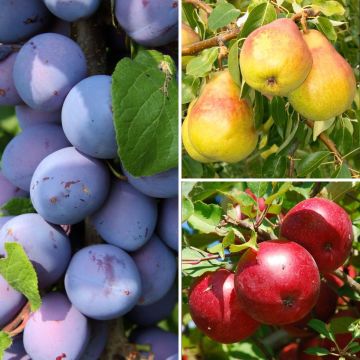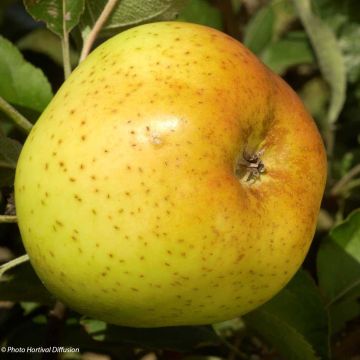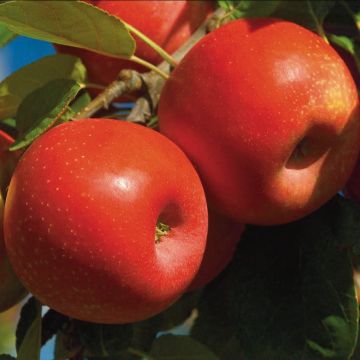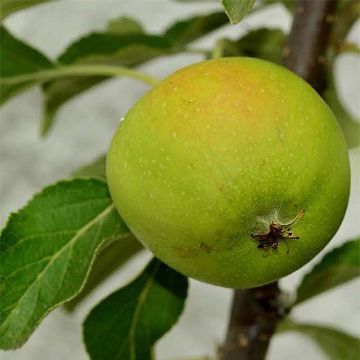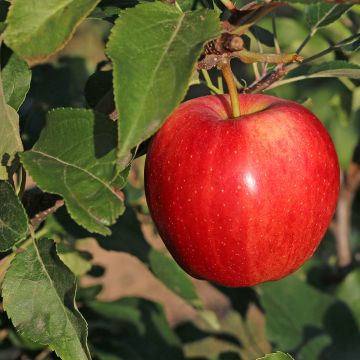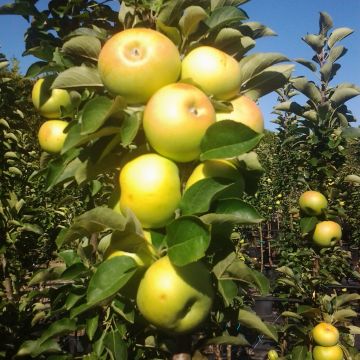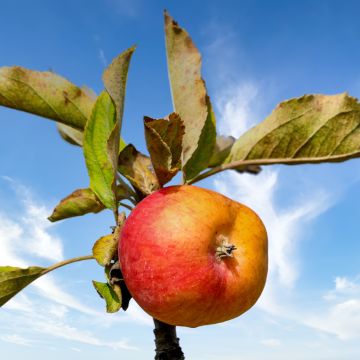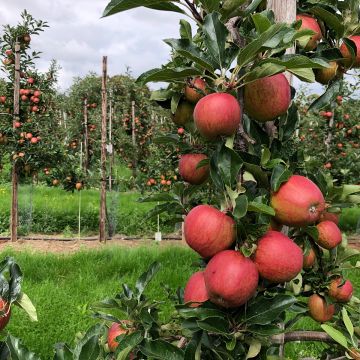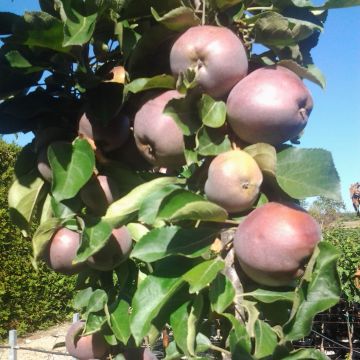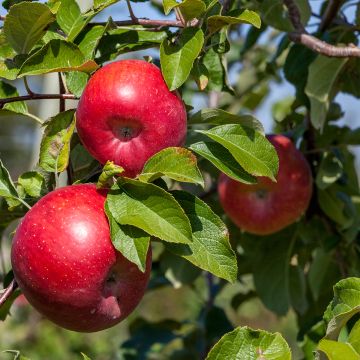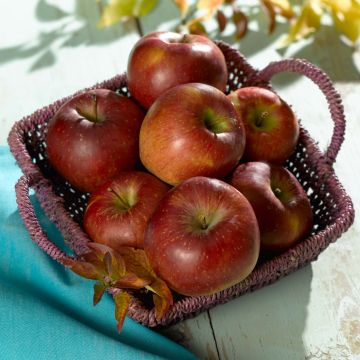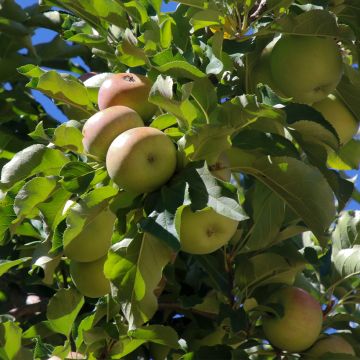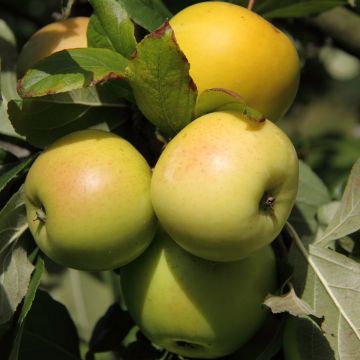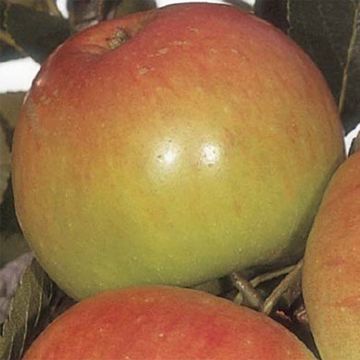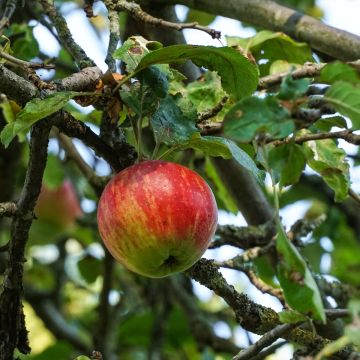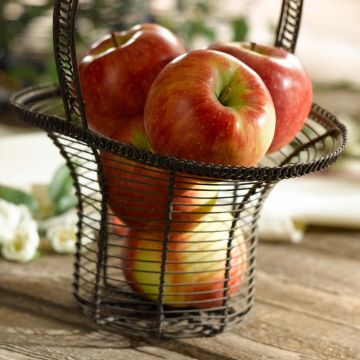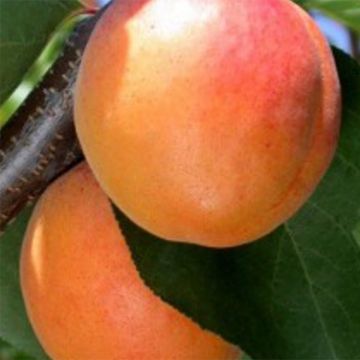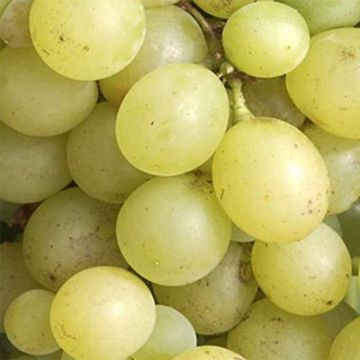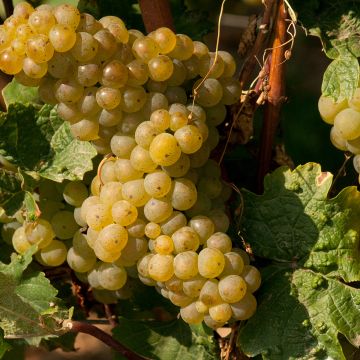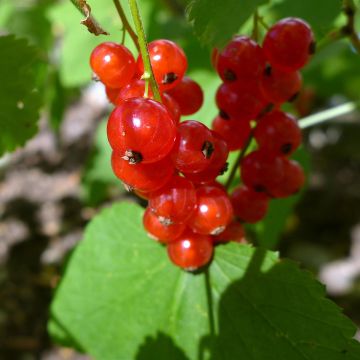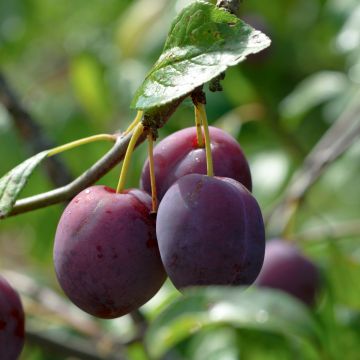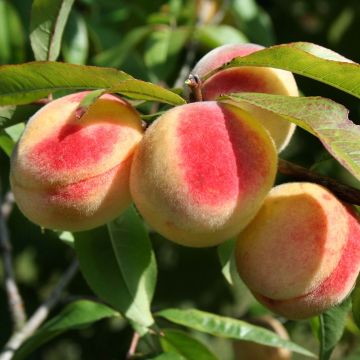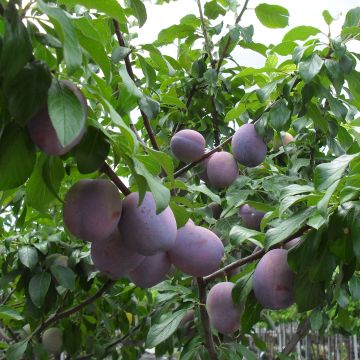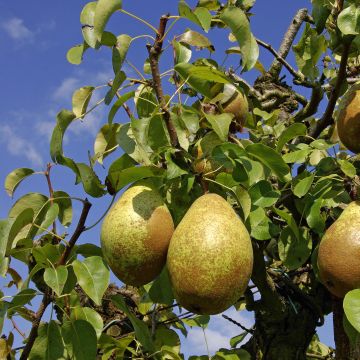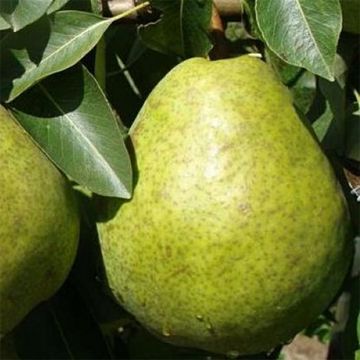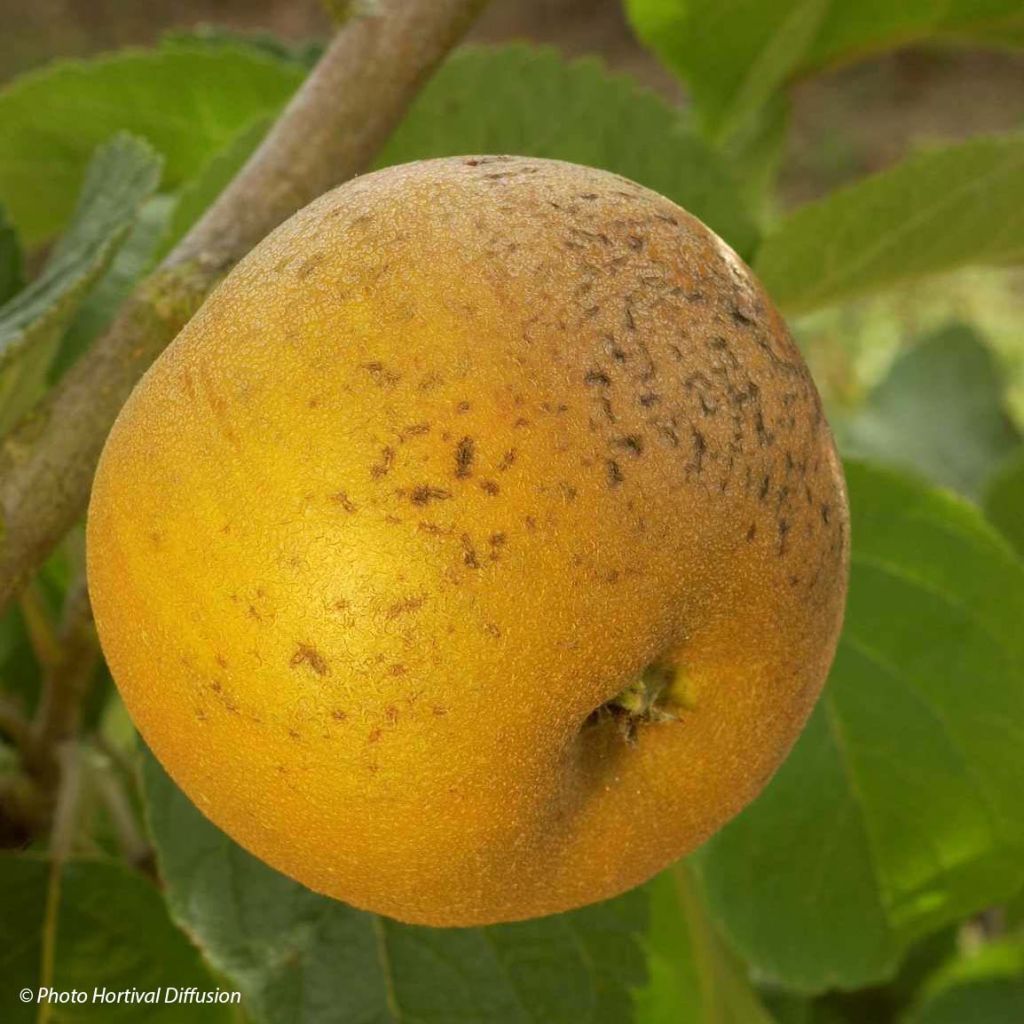

Pommier Patte de Loup
Apple Tree Patte de Loup - Malus domestica
Malus domestica Patte de Loup
Apple, Orchard apple, Table apple, Cultivated apple
Une pomme exceptionnelle à la juste maturité, des arômes riches, décrits par des noms de fruits exotiques divers. Pour un croqueur c'est un bonbon.
Tony, 05/01/2024
Why not try an alternative variety in stock?
View all →This plant carries a 6 months recovery warranty
More information
We guarantee the quality of our plants for a full growing cycle, and will replace at our expense any plant that fails to recover under normal climatic and planting conditions.
Oversize package: home delivery by special carrier from €6.90 per order..
Express home delivery from €8.90.

Description
The 'Patte de Loup' apple tree is an old variety, highly prized by lovers of tasty apples. It is a vigorous, fertile, and healthy tree. The fruits have a rather rustic appearance with their rough bronze-coloured skin, but they reveal a very original aromatic palette when tasted. It is also an excellent keeping apple that only deteriorates very slowly despite handling. Harvest takes place in October, but it will continue to ripen on the shelf; enjoy it from December until April.
The apple tree is a member of the Rosaceae family, its presence has been documented in Europe since antiquity. The 'Patte de Loup' variety has very ancient origins and was already appreciated in the Middle Ages. It is not very susceptible to diseases and withstands wind well. Productivity is very good and consistent. The relatively late flowering occurs between April and May when the most destructive frosts are over. It is self-sterile like many apple trees, the proximity of a good pollinator such as 'Queen of the Pippins', 'Cox's Orange Pippin', or 'Golden Delicious' is perfect. Harvest at the end of October to avoid frosts, but the apples will not reach their ripeness until December or even January. For storage, a cool and well-ventilated room is needed; the ideal temperature is 8°C (46.4°F), a garage or basement is better than a cellar, which is often too humid. The picked, harvested apples should be stored on clean shelves or crates, placed flat with the stem down and ideally separated from each other by a 1 or 2 cm (0 or 1in) gap.
The apples vary in size but remain small; they have thick, rough skin and are marked with scars. Their brownish-bronze colour does not look very appetizing, but 'Patte de Loup' is among the most flavourful apples. The slightly green, yellow flesh has a fine and compact grain and is crisp and sweet, revealing fruity and aniseed notes when eaten raw. It is also very good in pies and compotes; since it ripens late, it will take over from other varieties and ensure a supply of fruit throughout the winter.
Report an error about the product description
Apple Tree Patte de Loup - Malus domestica in pictures
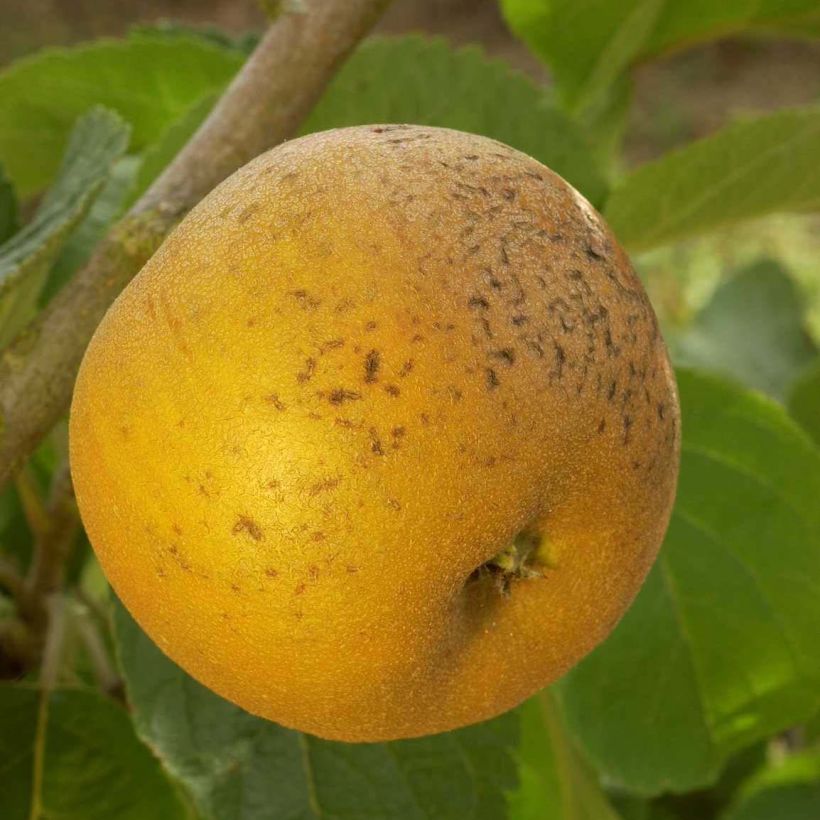

Plant habit
Fruit
Flowering
Foliage
Botanical data
Malus
domestica
Patte de Loup
Rosaceae
Apple, Orchard apple, Table apple, Cultivated apple
Cultivar or hybrid
Other Apple trees
Planting and care
Choose a sunny location for your 'Patte de Loup' Apple tree, the soil can be slightly chalky or acidic but not excessively so. This variety tolerates wind very well. Dig a large planting hole at least 3 times the size of the root ball and add organic matter (topsoil, compost...) and a slow-release fertiliser like bonemeal. Do not bury the graft collar. Stake if necessary. Water thoroughly immediately after planting, even in winter and even if it's raining. Fruit trees are best planted between October and November to promote root growth during the winter, avoid planting during freezing periods. Container-grown plants can be planted year-round, except during periods of extreme heat or frost.
In winter, you can add a small handful of wood ash which is rich in potassium and will improve fruiting. Watch out for potential aphid attacks during the season. A white powdery mildew caused by a fungus may appear on the leaves in summer, but it does not harm fruit development in gardens. Harvest takes place in October before the apples have reached full ripeness, so only keep the picked fruits. Store apples with the stem down on shelves or in crates. Choose a completely dark, dry and cool place, above freezing. Keep 'Patte de Loup' until at least mid-December before eating it, or else you won't fully enjoy its aromatic flavour.
Planting period
Intended location
Care
-
, onOrder confirmed
Reply from on Promesse de fleurs
Ancient and local varieties
Haven't found what you were looking for?
Hardiness is the lowest winter temperature a plant can endure without suffering serious damage or even dying. However, hardiness is affected by location (a sheltered area, such as a patio), protection (winter cover) and soil type (hardiness is improved by well-drained soil).

Photo Sharing Terms & Conditions
In order to encourage gardeners to interact and share their experiences, Promesse de fleurs offers various media enabling content to be uploaded onto its Site - in particular via the ‘Photo sharing’ module.
The User agrees to refrain from:
- Posting any content that is illegal, prejudicial, insulting, racist, inciteful to hatred, revisionist, contrary to public decency, that infringes on privacy or on the privacy rights of third parties, in particular the publicity rights of persons and goods, intellectual property rights, or the right to privacy.
- Submitting content on behalf of a third party;
- Impersonate the identity of a third party and/or publish any personal information about a third party;
In general, the User undertakes to refrain from any unethical behaviour.
All Content (in particular text, comments, files, images, photos, videos, creative works, etc.), which may be subject to property or intellectual property rights, image or other private rights, shall remain the property of the User, subject to the limited rights granted by the terms of the licence granted by Promesse de fleurs as stated below. Users are at liberty to publish or not to publish such Content on the Site, notably via the ‘Photo Sharing’ facility, and accept that this Content shall be made public and freely accessible, notably on the Internet.
Users further acknowledge, undertake to have ,and guarantee that they hold all necessary rights and permissions to publish such material on the Site, in particular with regard to the legislation in force pertaining to any privacy, property, intellectual property, image, or contractual rights, or rights of any other nature. By publishing such Content on the Site, Users acknowledge accepting full liability as publishers of the Content within the meaning of the law, and grant Promesse de fleurs, free of charge, an inclusive, worldwide licence for the said Content for the entire duration of its publication, including all reproduction, representation, up/downloading, displaying, performing, transmission, and storage rights.
Users also grant permission for their name to be linked to the Content and accept that this link may not always be made available.
By engaging in posting material, Users consent to their Content becoming automatically accessible on the Internet, in particular on other sites and/or blogs and/or web pages of the Promesse de fleurs site, including in particular social pages and the Promesse de fleurs catalogue.
Users may secure the removal of entrusted content free of charge by issuing a simple request via our contact form.
The flowering period indicated on our website applies to countries and regions located in USDA zone 8 (France, the United Kingdom, Ireland, the Netherlands, etc.)
It will vary according to where you live:
- In zones 9 to 10 (Italy, Spain, Greece, etc.), flowering will occur about 2 to 4 weeks earlier.
- In zones 6 to 7 (Germany, Poland, Slovenia, and lower mountainous regions), flowering will be delayed by 2 to 3 weeks.
- In zone 5 (Central Europe, Scandinavia), blooming will be delayed by 3 to 5 weeks.
In temperate climates, pruning of spring-flowering shrubs (forsythia, spireas, etc.) should be done just after flowering.
Pruning of summer-flowering shrubs (Indian Lilac, Perovskia, etc.) can be done in winter or spring.
In cold regions as well as with frost-sensitive plants, avoid pruning too early when severe frosts may still occur.
The planting period indicated on our website applies to countries and regions located in USDA zone 8 (France, United Kingdom, Ireland, Netherlands).
It will vary according to where you live:
- In Mediterranean zones (Marseille, Madrid, Milan, etc.), autumn and winter are the best planting periods.
- In continental zones (Strasbourg, Munich, Vienna, etc.), delay planting by 2 to 3 weeks in spring and bring it forward by 2 to 4 weeks in autumn.
- In mountainous regions (the Alps, Pyrenees, Carpathians, etc.), it is best to plant in late spring (May-June) or late summer (August-September).
The harvesting period indicated on our website applies to countries and regions in USDA zone 8 (France, England, Ireland, the Netherlands).
In colder areas (Scandinavia, Poland, Austria...) fruit and vegetable harvests are likely to be delayed by 3-4 weeks.
In warmer areas (Italy, Spain, Greece, etc.), harvesting will probably take place earlier, depending on weather conditions.
The sowing periods indicated on our website apply to countries and regions within USDA Zone 8 (France, UK, Ireland, Netherlands).
In colder areas (Scandinavia, Poland, Austria...), delay any outdoor sowing by 3-4 weeks, or sow under glass.
In warmer climes (Italy, Spain, Greece, etc.), bring outdoor sowing forward by a few weeks.


































